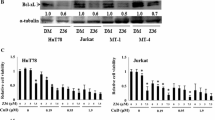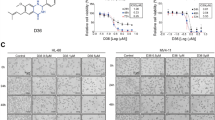Abstract
Leukemia is among the most aggressive and prevalent human malignant carcinoma. Chemotherapy is the preferred therapeutic strategy; however, recurrence of cancer and non-selective cytotoxicity are the major concerns. Unlike synthetic chemotherapeutic agents, mistletoe ribosome-inactivating protein (RIP) displays anti-tumor function in various types of cancers. However, its effect on leukemia cells is little explored. In this study, we assessed the impact of Viscum articulatum RIP (Articulatin-D) on the survival of acute T-cell leukemia cells and the involved molecular and cellular mechanisms. Cell proliferation assay showed that Articulatin-D suppressed the viability of leukemia cells selectively. We further confirmed that the elevation of mitochondrial membrane potential and exposure of phosphatidylserine are the early events of apoptosis induction in Articulatin-D-treated Jurkat cells. Subsequently, we found that Articulatin-D treatment induces apoptosis in Jurkat cells in a time- and concentration-dependent manner. In conclusion, we provided evidence that Articulatin-D efficiently activates caspase-8 involved in extrinsic pathway of apoptosis induction, which ultimately results in caspase-3-dependent DNA fragmentation of Jurkat cells. Further evaluation of Articulatin-D in cell culture and animal models may provide novel information on selective cytotoxicity to acute T-cell leukemia and its involvement in targeting tumor cell survival pathways.







Similar content being viewed by others
References
Torre LA, Bray F, Siegel RL, Ferlay J, Lortet-tieulent J, Jemal A (2015) Global cancer statistics, 2012. CA Cancer J Clin 65:87–108
Gaynon PS (2005) Childhood acute lymphoblastic leukaemia and relapse. Br J Haematol 131:579–587
Lichtman MA (2008) Battling the hematological malignancies: the 200 years’ war. Oncologist 13:126–138
Voliotis D, Diehl V (2002) Challenges in treating hematologic malignancies. Semin Oncol 29:30–39
Siegel R, Desantis C, Virgo K, Stein K, Mariotto A, Smith T, Cooper D, Gansler T, Lerro C, Fedewa S, Lin C, Leach C, Cannady RS, Cho H, Scoppa S, Hachey M, Kirch R, Jemal A, Ward E (2013) Cancer treatment and survivorship statistics, 2012. CA Cancer J Clin 62:220–241
Vagace JM, Gervasini G (2010) Chemotherapy toxicity in patients with acute leukemia—The scientist’s perspective and challenge. Available from http://www.intechopen.com/books/acute-leukemia-the-scientist-sperspective-and-challenge/chemotherapy-toxicity-in-patients-with-acute-leukemia
Pryme IF, Bardocz S, Pusztai A, Ewen SWB (2006) Suppression of growth of tumour cell lines in vitro and tumours in vivo by mistletoe lectins. Histol Histopathol 21:285–299
Grossarth-Maticek R, Ziegler R (2006) Randomised and non-randomised prospective controlled cohort studies in matched-pair design for the long-term therapy of breast cancer patients with a mistletoe preparation (Iscador): a re-analysis. Eur J Med Res 11:485–495
Goebell PJ, Thomas O, Julia S, Herbert R (2002) Evaluation of an unconventional treatment modality with Mistletoe lectin to prevent recurrence of superficial bladder cancer: a randomized phase II trial. J Urol 168:72–75
Bar-Sela G, Haim N (2004) Abnoba-viscum (Mistletoe extract) in metastatic colorectal carcinoma resistant to 5-fluorouracil and leucovorin-based chemotherapy. Med Oncol 21:251–254
Bar-Sela G, Wollner M, Hammer L, Agbarya A, Dudnik E, Haim N (2013) Mistletoe as complementary treatment in patients with advanced non-small-cell lung cancer treated with carboplatin-based combinations: a randomised phase II study. Eur J Cancer 49:1058–1064
Horneber M, Bueschel G, Huber R, Linde K, Rostock M (2010) Mistletoe therapy in oncology. Cochrane Libr 4:4–6
Stirpe F, Battelli MG (2006) Ribosome-inactivating proteins: progress and problems. Cell Mol Life Sci 63:1850–1866
Büssing A (1996) Induction of apoptosis by the mistletoe lectins: a review on the mechanisms of cytotoxicity mediated by Viscum album L. Apoptosis 1:25–32
Mishra V, Sharma RS, Yadav S, Babu CR, Singh TP (2004) Purification and characterization of four isoforms of Himalayan mistletoe ribosome-inactivating protein from Viscum album having unique sugar affinity. Arch Biochem Biophys 423:288–301
Mishra V, Ethayathulla AS, Sharma RS, Yadav S, Krauspenhaar R, Betzel C, Babu CR, Singh TP (2004) Structure of a novel ribosome-inactivating protein from a hemi-parasitic plant inhabiting the northwestern Himalayas. Acta Crystallogr D Biol Crystallogr 60:2295–2304
Mishra V, Bilgrami S, Sharma RS, Kaur P, Yadav S, Krauspenhaar R, Betzel C, Voelter W, Babu CR, Singh TP (2005) Crystal structure of himalayan mistletoe ribosome-inactivating protein reveals the presence of a natural inhibitor and a new functionally active sugar-binding site. J Biol Chem 280:20712–20721
Das MK, Sharma RS, Mishra V (2011) A cytotoxic type-2 ribosome inactivating protein (from leafless mistletoe) lacking sugar binding activity. Int J Biol Macromol 49:1096–1103
Das MK, Sharma RS, Mishra V (2012) Induction of apoptosis by ribosome inactivating proteins. Appl Biochem Biotechnol 166:1552–1561
Shanavaskhan AE, Sivadasan M, Alfarhan AH, Thomas J (2012) Ethnomedicinal aspects of angiospermic epiphytes and parasites of Kerala, India. Indian J Tradit Knowl 11:250–258
Singh H, Krishna G, Baske PK (2010) Plants used in the treatment of joint diseases (rheumatism, arthritis, gout and lumbago) in Mayurbhanj district of Odisha, India. Rep Opin 2:22–26
Pradhan BK, Badola HK (2008) Ethnomedicinal plant use by Lepcha tribe of Dzongu valley, bordering Khangchendzonga biosphere reserve, in north Sikkim, India. J Ethnobiol Ethnomed 4:22
Wiart C (2012) Medicinal plants of China, Korea, and Japan: bioresources for tomorrow’s drugs and cosmetics. Taylor & Francis, Boca Raton
Liu Y (1986) Pharmaceutical composition for treating nonlymphatic leukemia and method of producing the same and its components. Chem Abstr 106:90200j
Bradford MM (1976) A rapid and sensitive method for the quantitation of microgram quantities of protein utilizing the principle of protein-dye binding. Anal Biochem 72:248–254
Vermes I, Haanen Steffens-Nakken H, Reutelingsperger C (1995) A novel assay for apoptosis flow cytometric detection of phosphatidylserine expression on early apoptotic cells using fluorescein labelled Annexin V. J Immunol Methods 184:39–51
Battelli MG, Citores L, Buonamici L, Ferreras JM, De Benito FM, Stirpe F, Girbés T (1997) Toxicity and cytotoxicity of nigrin b, a two-chain ribosome-inactivating protein from Sambucus nigra: comparison with ricin. Arch Toxicol 71:360–364
Ayyagari VN, Brard L (2014) Bithionol inhibits ovarian cancer cell growth in vitro-studies on mechanism(s) of action. BMC Cancer 14:61–77
Ding X, Zhu FS, Li M, Gao SG (2012) Induction of apoptosis in human hepatoma SMMC-7721 cells by solamargine from Solanum nigrum L. J Ethnopharmacol 139:599–604
Gercel-Taylor C (2005) Diphenylamine assay of DNA fragmentation for chemosensitivity testing. Methods Mol Med 111:79–82
Sikriwal D, Batra JK (2010) Ribosome inactivating proteins and apoptosis. Plant Cell Monogr 18:167–189
Saxena N, Yadav P, Kumar O (2013) The Fas/Fas ligand apoptotic pathway is involved in abrin-induced apoptosis. Toxicol Sci 135:103–118
Bantel H, Engels IH, Voelter W, Klaus SO, Sebastian W (1999) Mistletoe lectin activates caspase-8/FLICE independently of death receptor signaling and enhances anticancer drug-induced apoptosis. Cancer Res 59:2083–2090
Narayanan S, Surolia A, Karande A (2004) Ribosome-inactivating protein and apoptosis: abrin causes cell death via mitochondrial pathway in Jurkat cells. Biochem J 377:233–240
Elmore S (2007) Apoptosis: a review of programmed cell death. Toxicol Pathol 35:495–516
Hickman JA (1992) Apoptosis induced by anticancer drugs. Cancer Metastasis Rev 11:21–139
Perl A, Gergely PJ, Nagy G, Koncz A, Banki K (2004) Mitochondrial hyperpolarization: a checkpoint of T-cell life, death and autoimmunity. Trends Immunol 25:360–367
Sánchez-Alcázar J, Ault J, Khodjakov A, Schneider E (2000) Increased mitochondrial cytochrome c levels and mitochondrial hyperpolarization precede camptothecin-induced apoptosis in Jurkat cells. Cell Death Differ 7:1090–1100
Scarlett JL, Sheard PW, Hughes G, Ledgerwood EC, Ku HH, Murphy MP (2000) Changes in mitochondrial membrane potential during staurosporine-induced apoptosis in Jurkat cells. FEBS Lett 475:267–272
Vander Heiden MG, Chandel NS, Li XX, Schumacker PT, Colombini M, Thompson CB (2000) Outer mitochondrial membrane permeability can regulate coupled respiration and cell survival. Proc Natl Acad Sci USA 97:4666–4671
Kim WH, Park WB, Gao B, Jung MH (2004) Critical role of reactive oxygen species and mitochondrial membrane potential in Korean mistletoe lectin-induced apoptosis in human hepatocarcinoma cells. Mol Pharmacol 66:1383–1396
Rao PVL, Jayaraj R, Bhaskar ASB, Kumar O, Bhattacharya R, Saxena P, Dash PK, Vijayaraghavan R (2005) Mechanism of ricin-induced apoptosis in human cervical cancer cells. Biochem Pharmacol 69:855–865
Aronis A, Melendez JA, Golan O, Shilo S, Dicter N, Tirosh O (2003) Potentiation of Fas-mediated apoptosis by attenuated production of mitochondria-derived reactive oxygen species. Cell Death Differ 10:335–344
Gulzeb A (2014) Procaspase-3 activating therapeutic agents in cancer therapy. Adv Pharm Ethanomed 2:1–6
Lyu SY, Park WB, Choi KH, Kim WH (2001) Involvement of caspase-3 in apoptosis induced by Viscum album var. coloratum agglutinin in HL-60 cells. Biosci Biotechnol Biochem 65:534–541
Kim MS, So HS, Lee KM, Park JS, Lee JH, Moon SK, Ryu DG, Sy Chung, Jung BH, Kim YK, Moon G, Park R (2000) Activation of caspase cascades in Korean mistletoe (Viscum album var. coloratum) lectin-II-induced apoptosis of human myeloleukemic U937 cells. Gen Pharmacol Vasc Syst 34:349–355
Acknowledgements
Authors thank the University of Delhi for Faculty research grant to VM, Miranda House for Flow Cytometer facility of the DS Kothari Centre for Research and Innovation in Science Education. RM thanks the University Grant Commission for JRF for Ph.D. and SS thanks the UGC for Non-NET Research Fellowship. Authors thank Professor Millind Sardesai for all support throughout the study.
Author information
Authors and Affiliations
Corresponding author
Rights and permissions
About this article
Cite this article
Mishra, R., Das, M.K., Singh, S. et al. Articulatin-D induces apoptosis via activation of caspase-8 in acute T-cell leukemia cell line. Mol Cell Biochem 426, 87–99 (2017). https://doi.org/10.1007/s11010-016-2883-y
Received:
Accepted:
Published:
Issue Date:
DOI: https://doi.org/10.1007/s11010-016-2883-y




